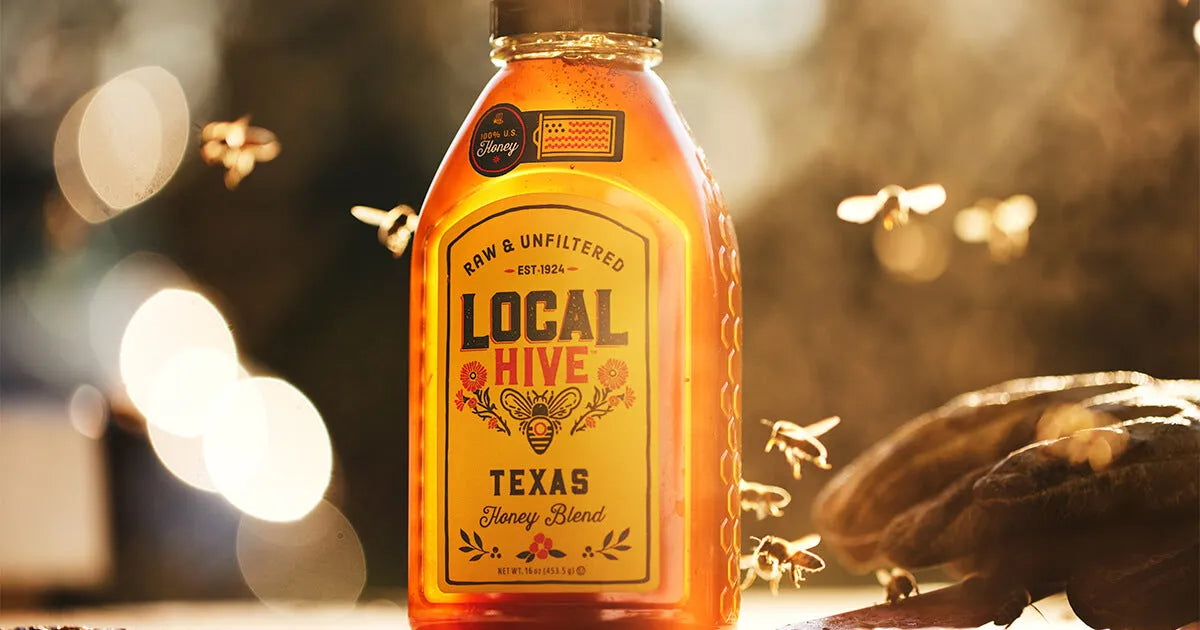How Much Honey Does a Bee Make?
Honey Facts
Honeybees are small. Really small. Each one is barely the size of a fingernail. Yet, somehow, all the bees in the U.S. make 125,000,000 pounds of honey every year. That’s more than the Titanic weighed! That means every year, U.S. bees make a literal boatload of honey.
But how much does just one bee make on her own? Let’s find out.

On average, a worker honeybee will produce about 1/12th of a teaspoon of honey in her entire lifetime. So, a single 16oz. bottle of Local Hive Honey takes more than 1,100 bees just to gather the pollen and nectar inside. That’s not even counting all the work of the other bees who clean up the hive, build honeycomb and protect the entrance.
A strong hive can be home to 50–100,000 bees during the peak of the summer. Do a little quick math, and you see how beekeepers arrive at an average of 60lbs. of honey per hive, per year. With the right weather and the right beekeeper, some hives can even produce 100lbs. in a year.
The Sweet Steps to Honey
Turning the nectar that worker bees forage for into honey that bees – and humans – can store indefinitely is no small feat. It takes the whole hive working in tandem.
Foraging for Nectar: Forager bees go out of the hive to collect nectar from flowers. They use their long proboscis (tongue) to suck up nectar, a sugary liquid produced by flowers just to attract pollinators like bees.
Carrying Nectar: Forager bees carry the collected nectar back to the hive in their honey stomachs. Enzymes in their stomachs begin to break down the complex sugars in the nectar into simpler sugars, primarily glucose and fructose. In a single collecting trip, a worker will visit between 50 and 100 flowers. She will return to the hive carrying over half her weight in pollen and nectar.
Deposit in Honeycomb Cells: To make one pound of honey, workers in a hive can fly 55,000 miles and visit two million flowers. Once back at the hive, the worker bees regurgitate the partially digested nectar into honeycomb cells that the hive has been building. These cells are made of beeswax and are hexagonal in shape. The bees then fan their wings to evaporate some of the water content from the nectar, making it thicker.
Ripening and Capping: The bees continue to fan and reduce the moisture content of the nectar until it reaches the desired consistency, which is about 17–18% water. With less water, the nectar is more viscous and more protected from mold. Once it’s sufficiently thickened, the bees seal the cell with a wax cap to protect the honey from moisture and contaminants.

Beekeepers generally don’t harvest honey until they find a super (a removable frame that bees instinctively fill with honeycomb) that’s completely filled and capped. Checking on hives throughout the harvest season is like watching a house being built. One day, it’s just a frame. The next, it’s partly filled. Before you know it, the busy bees have built, filled and capped tens of thousands of tiny combs with honey.
A Human-Hive Partnership
Honeybees live and die as a hive. A single worker bee might be born in April and live until August. All the while, she’s gathering honey to help the next generation survive the coming winter. It’s a noble sacrifice that beekeepers have to respect every time they harvest. If they take too much honey, the hive won’t make it through the winter. Bees have a strong instinct to produce as much honey as possible, but in extreme cases, like inclement weather, they can still benefit from a beekeeper to help feed and protect them.
Check out all of our raw & unfiltered Local Hive Honey blends here.

